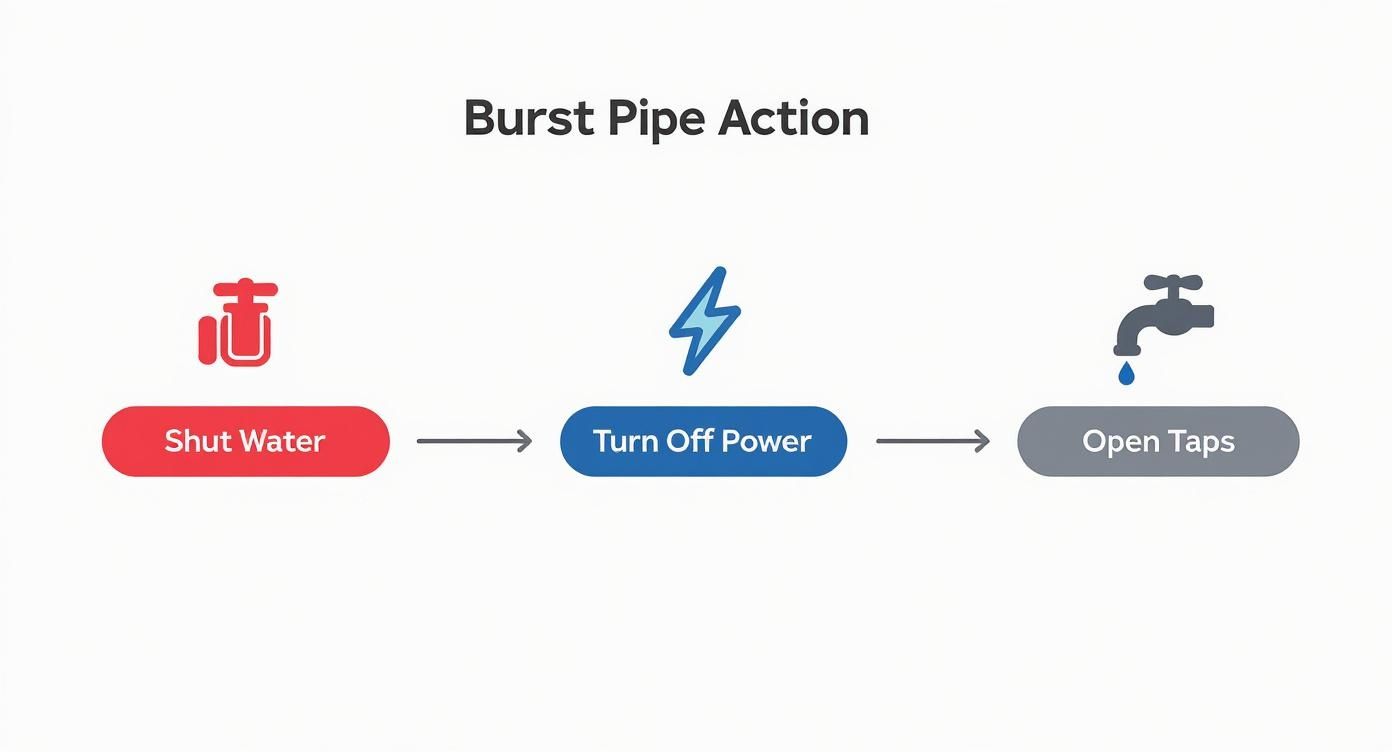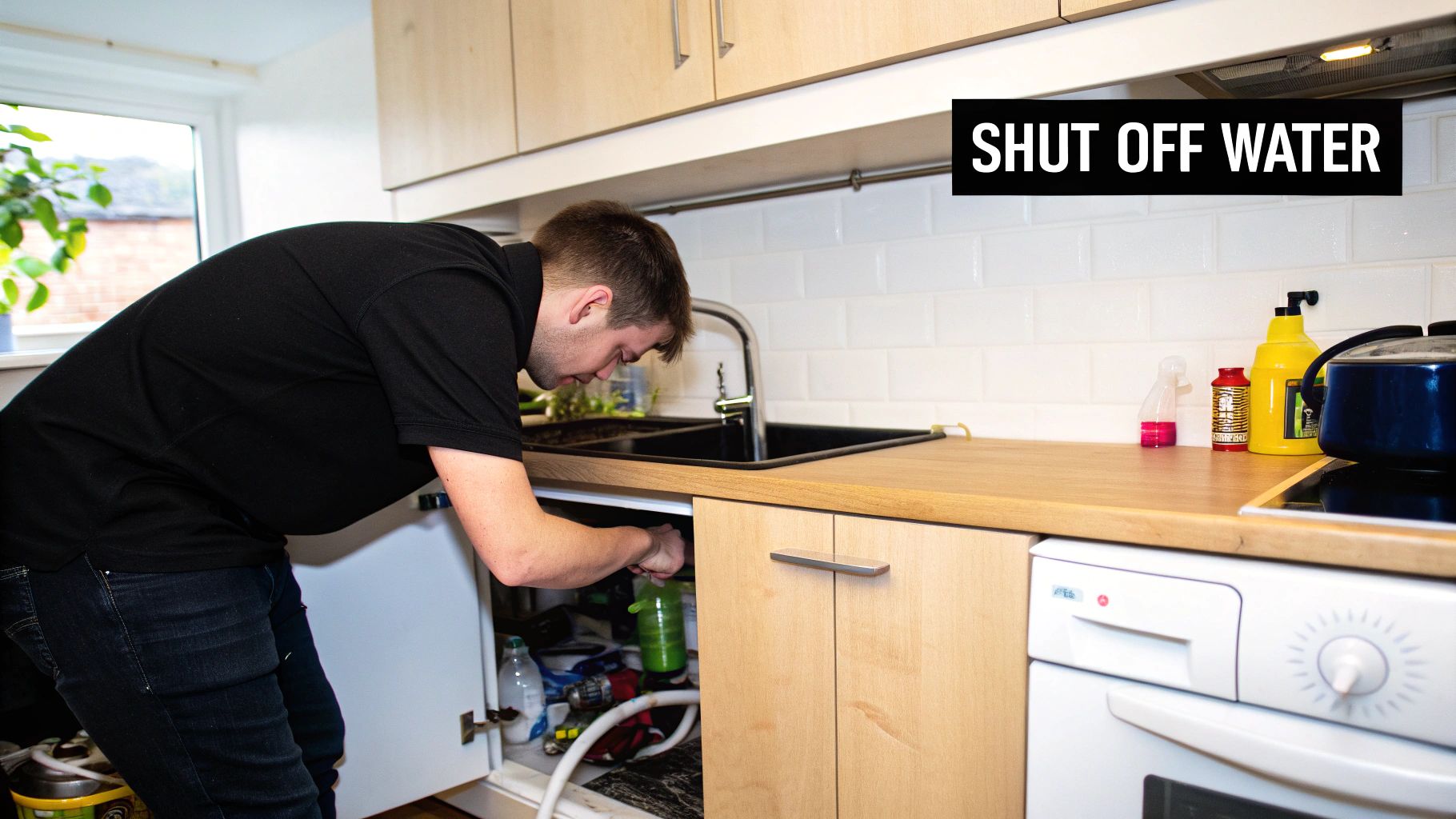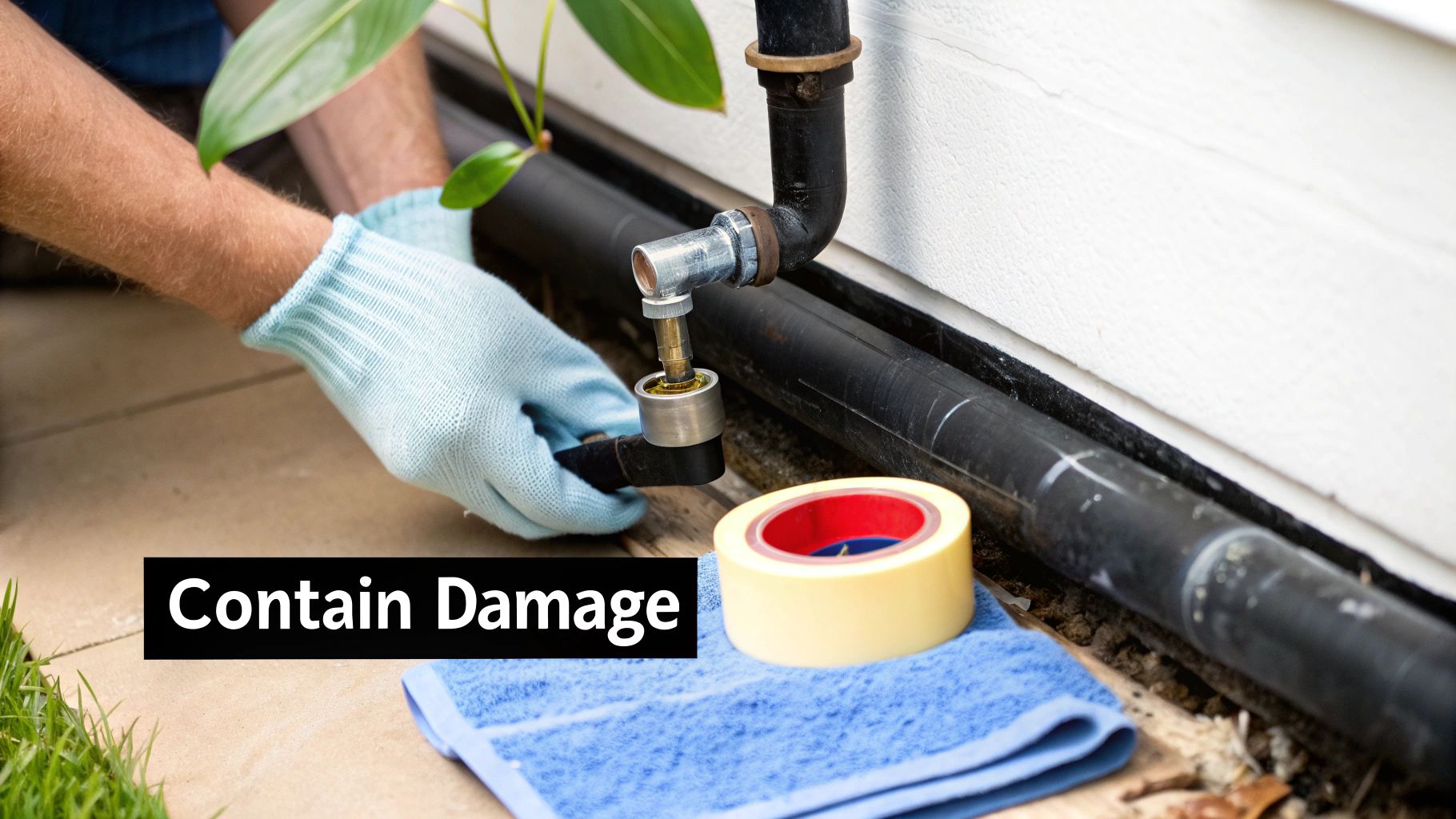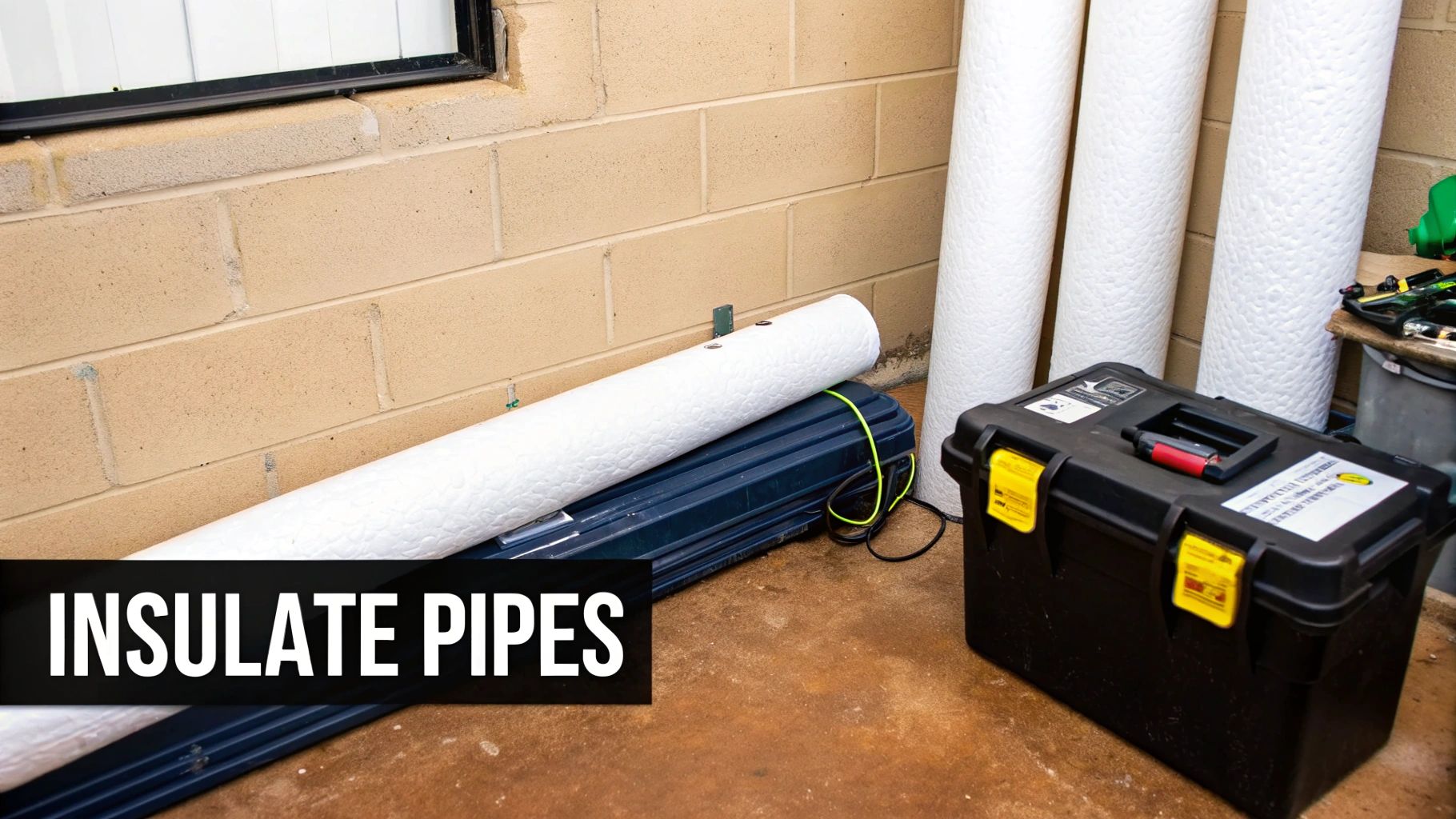How to handle burst pipes in house: quick fixes & fast help
- Luke Yeates
- 2 days ago
- 13 min read
That sudden sound of rushing water when everything should be quiet is enough to make any homeowner's heart sink. It's a classic sign of a burst pipe in house, and it can trigger instant panic. What you do in the first five minutes is absolutely crucial to protecting your home and limiting the damage. Think of these immediate actions as your first line of defence, buying you precious time before a professional plumber can get there.
Your Immediate Action Plan for a Burst Pipe
That sinking feeling is universal, but how you react can completely change the outcome. Whether you're in a classic Victorian terrace in Eastbourne's Meads district or a modern build in Sovereign Harbour, your first priority is the same: get control of the situation, fast. This isn't just about stopping a mess; it's about knowing exactly what to do before the water causes thousands of pounds in damage.
The very first thing you need to do is shut off your home's main water supply. This single action stops the flow of water feeding the leak, immediately putting a cap on the potential destruction. The trouble is, from our experience at Harrlie Plumbing and Heating, many homeowners in Eastbourne have no idea where their main stopcock is. It's usually under the kitchen sink, in a utility cupboard, or sometimes near the front of the property where the service pipe enters your home. For a detailed walkthrough, check out our guide on how to turn off your water main.
This infographic breaks down the simple, three-step process to follow the second you realise you have a problem.

As you can see, after stopping the water, your next priorities are electrical safety and then releasing any pressure left in the system.
Safety First: Electrics and Water Pressure
If water is anywhere near electrical outlets, appliances, or your fuse box, shut off the electricity at the consumer unit immediately. I can't stress this enough. Water and electricity are a lethal mix, and this step is non-negotiable for your safety. We've seen situations in Eastbourne where water has dripped directly into a fuse box in a cellar – it’s incredibly dangerous.
Once the water and power are off, go around the house and open all the cold taps. This helps drain the remaining water out of the plumbing system. It also relieves any built-up pressure, which can slow the leak from the burst pipe right down to a trickle.
To help you remember these critical actions under pressure, here’s a quick-reference table.
First 5 Minutes Checklist for a Burst Pipe
This checklist outlines the crucial first steps to take the moment you discover a burst pipe in your home.
Action | Why It's Critical | Eastbourne-Specific Tip |
|---|---|---|
Turn off the main stopcock | Immediately stops the flow of water, preventing further flooding and damage. | In many older Eastbourne properties, the stopcock can be stiff. It’s worth checking and turning it once a year to keep it from seizing up. |
Switch off the electricity | Prevents the risk of electric shock if water comes into contact with wiring or appliances. | If your consumer unit is in a damp cellar or area affected by the leak, do not touch it. Call an emergency electrician first. |
Open all cold taps | Drains the system and relieves water pressure, slowing the leak significantly. | Don't forget taps in the garden or utility rooms. The more you open, the faster the system will drain. |
Place buckets/towels | Catches dripping water to protect floors and ceilings from immediate saturation. | In a pinch, even oven trays or large cooking pots can work to contain the water. |
Taking these steps quickly can make a huge difference in the amount of damage your home sustains.
Taking these initial steps transforms you from a victim of the situation into the person in control. It's the difference between a manageable repair and a catastrophic insurance claim. At Harrlie Plumbing and Heating, we always advise clients to familiarise themselves with these procedures before an emergency strikes.
Beyond shutting off the water, understanding the immediate water damage restoration steps can further protect your home and minimise the mess. These first actions are vital for containing the problem until an expert from a team like ours at Harrlie Plumbing and Heating can get there, assess the situation, and carry out a permanent repair.
Locating the Source of the Water Damage

Alright, with the water and power off, you can take a steadying breath. That initial wave of panic is over. Now, it’s time to switch gears and become something of a detective. When you have a burst pipe in house, the real problem is rarely where the most dramatic water damage shows up.
Water is a sneaky traveller. It will happily run along a ceiling joist, trickle down the inside of a wall, and create a puddle miles from the actual burst. That damp patch blooming on your living room ceiling? It could easily be from a leaking pipe under the shower upstairs.
Following the Clues
You'll need to start your search in the places where pipes are most vulnerable to cold or stress. These are the usual suspects, especially in the mix of older and newer homes we see across Eastbourne.
Get methodical and start checking these common culprit areas:
Uninsulated Spaces: Lofts, cellars, and garages are classic weak spots. Any pipes running through these chilly zones are prime candidates for freezing.
Under Sinks and Behind Appliances: Take a good look at the pipework beneath your kitchen and bathroom sinks. Don't forget to pull out the washing machine and dishwasher to check the supply lines tucked away behind them.
Exposed External Pipes: Cast a critical eye over any pipework running along the outside walls of your home. They’re completely exposed to those brisk coastal winds we get in Eastbourne.
We once had a callout to a beautiful old terraced house in Eastbourne’s Old Town. The owner was stumped by a damp patch on a brand-new extension wall. It turned out an original copper pipe had been boxed into the new cavity wall without any insulation. The first proper cold snap was all it took.
Recognising the Telltale Signs
Your own senses are your best tools here, going beyond just looking for obvious drips. You're looking and listening for the subtle clues that will lead you to the source. For a more detailed guide, our team at Harrlie Plumbing and Heating has put together some easy tips on how to find a water leak in your home.
Keep an eye (and ear) out for these indicators:
Visual Damage: This isn't just puddles. Look for bulging or discoloured plasterboard, wallpaper that's starting to peel, or floorboards that are beginning to warp.
Musty Odours: A persistent damp, earthy smell is a big red flag. It often means water has been leaking for a while, giving mould or mildew a chance to grow.
Audible Clues: Even with the mains off, get close to the walls and floors and listen. You might just catch the faint sound of dripping or hissing that will give the game away.
Pinpointing the general area of the burst pipe is incredibly helpful. When you call Harrlie Plumbing and Heating, being able to say, "I think the leak is in the upstairs bathroom wall" gives us a crucial head start, saving time and helping us prepare the right tools for the job.
By narrowing down the location, you’re providing vital information that helps us get to a fix much faster when we arrive. This initial investigation is a key step in getting the whole situation under control.
Temporary Fixes and Containing the Damage
Right, with the water shut off, the immediate panic has likely passed. Now, it's time to shift gears into damage limitation mode by containing the mess and applying a safe, temporary fix. These steps aren't going to solve the root problem of a burst pipe in house, but they are absolutely essential for preventing thousands of pounds in additional damage while you wait for a professional to arrive.
It’s crucial to remember that these are just stop-gap measures. A permanent, professional repair is the only way to guarantee your home’s long-term safety and avoid a repeat performance. However, a quick patch can turn a gushing torrent into a manageable drip, buying you precious time.
Choosing Your Temporary Patch
For small pinhole leaks or minor splits, you have a few solid DIY options that you can grab from any local hardware shop. Self-fusing silicone tape is fantastic for tiny leaks; you simply stretch it and wrap it tightly over the hole. It bonds to itself to create a surprisingly strong waterproof seal.
For slightly bigger cracks, a pipe repair clamp or some epoxy putty will be your best bet.
Pipe Repair Clamp: This is a metal sleeve with a rubber lining inside. You just place it over the split and tighten the screws to clamp it down, forming a really effective mechanical seal. It's a go-to temporary fix for a reason.
Epoxy Putty: This is a two-part putty that you knead together until it’s one uniform colour. You then press it firmly over the damaged bit of the (now dry) pipe. It hardens like steel in about an hour, creating a solid patch.
We once got a call from a homeowner in Willingdon who had used epoxy putty on a leaking copper pipe under their sink. It held perfectly for the two hours it took for our Harrlie Plumbing and Heating team to get there, preventing what would have been a completely ruined kitchen cabinet.
Damage Control and Insurance Prep
Beyond patching the pipe, you need to deal with the water that has already escaped. The quicker you act, the less secondary damage—like mould and rot—you'll have to contend with. First things first, get the area drying out. Open some windows to get air circulating and, if you have them, set up fans and dehumidifiers aimed at the wettest spots.
Next, focus on moving valuables. Get any furniture with wooden legs, rugs, and electrical items out of the affected area immediately. Water can wick up into wood and fabrics astonishingly quickly, causing irreversible swelling and staining.
Before you start cleaning up too much, take photos and videos of everything. Document the burst pipe itself, the standing water, and any damaged belongings. This evidence is absolutely vital when you make your insurance claim.
Once you've documented the scene, start removing as much standing water as you can with mops, buckets, and old towels. If you're dealing with a large amount of water, a wet/dry vacuum can be a real lifesaver. This initial clean-up is a critical part of mitigating the damage. Your insurer will want to see that you took reasonable steps to limit the destruction after discovering the leak. These actions show you’ve done just that, which will strengthen your claim and help protect your home.
When to Call a Professional Eastbourne Plumber

A temporary patch is a brilliant bit of first aid, but you've got to know its limits. The line between a quick fix and a serious plumbing disaster can be incredibly thin, and recognising when it's time to call in the experts is crucial for a safe, permanent solution to a burst pipe in house. Trust me, trying to tackle a major repair without the right training or tools can turn a bad situation into a catastrophe.
It’s tempting to try and save a few quid with a DIY repair, but it can quickly backfire and cost you a lot more. The financial fallout from burst pipes in the UK is staggering; in 2023, weather-related insurance claims for burst pipes hit £153 million. The average cost to fix the resulting damage in a single home was around £9,300. You can read more about it in this report from the Association of British Insurers. A botched repair not only adds to these costs but could even give your insurer a reason to reject your claim.
Signs You Need an Expert Immediately
Some situations just aren't negotiable and demand a professional plumber straight away. If you spot any of these red flags, it's time to pick up the phone and call Harrlie Plumbing and Heating.
Leaks Hidden Inside Walls or Ceilings: If you can see a growing damp patch but can’t see the pipe, don't just start hacking away at your plasterboard. We use specialist gear like acoustic listeners and thermal imaging cameras to pinpoint leaks without causing unnecessary destruction.
The Central Heating System is Involved: A burst pipe connected to your boiler or radiators is a whole different ball game. You’re dealing with the system’s pressure and temperature, which means you need a Gas Safe registered engineer to handle it safely.
Low Water Pressure After the Burst: Still got stubbornly low pressure even after your temporary patch? That can be a sign of a much bigger, hidden problem somewhere else in the system.
You're Not Confident: If at any point you feel unsure or out of your depth, that’s your signal to stop. A professional repair gives you the peace of mind that the job is done right and complies with all UK plumbing regulations.
For Eastbourne residents, calling a local, trusted company like Harrlie Plumbing and Heating means you’re not just getting a plumber. You're getting a team that understands the unique challenges of our local homes, from coastal properties to older terraced houses.
The Value of a Professional Repair
A professional plumber doesn’t just patch the leak; we restore the integrity of your entire plumbing system. We'll assess the condition of the surrounding pipes, identify other weak spots that might fail in the future, and make sure the repair is solid enough to last for years. That sort of preventative insight is priceless.
Just recently, we were called out to a house in the Roselands area of Eastbourne where the homeowner had applied a temporary patch to a small leak. Our engineer at Harrlie Plumbing and Heating quickly saw that the whole section of pipe was badly corroded because of its age. A simple patch would have failed again within months. Instead, we replaced the entire section, preventing another emergency call-out and securing the system for the long haul. That’s the difference professional expertise makes.
How to Prevent Future Pipe Bursts
Dealing with the aftermath of a burst pipe is a stressful, expensive ordeal. The absolute best way to handle a burst pipe in house is to make sure it never happens in the first place. A bit of proactive prevention is far less disruptive than emergency repairs, especially during a cold snap.
The concept is simple: keep your pipes from freezing. When water turns to ice, it expands by about 9%. That expansion puts immense pressure on the pipe until it eventually splits. This is exactly why insulation is your first and most powerful line of defence.
Insulate Your Vulnerable Pipes
Think about the coldest parts of your home—these are where your pipes are most at risk. In Eastbourne, we at Harrlie Plumbing and Heating often find the most vulnerable pipework in areas that homeowners might overlook until it’s far too late.
Your main targets for insulation should be:
Lofts and Attics: Any pipes running through these unheated spaces are completely exposed to freezing temperatures.
Garages and Outbuildings: Just like lofts, these areas lack the consistent warmth of the main house.
External Walls: Pay special attention to pipes for outdoor taps. That bracing, damp coastal wind we get in Eastbourne can put extra stress on this external pipework.
Pipe lagging, which is essentially a foam tube that slips right over your pipes, is cheap, effective, and surprisingly easy to install. It’s one of the most cost-effective investments you can make to protect your plumbing. For more detailed advice, you can check out our guide on how to prevent frozen pipes right here in Eastbourne.
Smart Heating Habits for Cold Weather
Your central heating is another key tool in preventing burst pipes. If you’re heading away for a few days during winter, it can be tempting to turn the heating off completely to save a bit of money. This is a mistake we see all too often in Eastbourne call-outs.
Leaving your heating on a low, constant setting—around 12-15°C—is vital. This allows just enough warm air to circulate and keep the ambient temperature above freezing, protecting the pipes hidden inside your walls. The small cost of running the heat is nothing compared to the expense of a major water damage repair.
At Harrlie Plumbing and Heating, we always advise clients in Eastbourne that a little bit of heat goes a long way. Think of it as cheap insurance for your entire plumbing system during the coldest months of the year.
The Value of Regular Maintenance
Finally, nothing beats a professional inspection. An annual plumbing check-up allows an expert from Harrlie Plumbing and Heating to spot potential problems before they become full-blown emergencies. We can identify corroded sections, weak joints, or poorly insulated areas that you might easily miss.
This isn’t just a theoretical risk; the issue is significant across the country. According to one major insurer, around 2,650 domestic pipes burst annually in the UK, leading to nearly £50 million in repair costs, with January and February being the peak months. You can discover more insights about these UK burst pipe statistics on Direct Line's website.
By taking these preventative steps, you dramatically reduce the chances of ever having to deal with the chaos of a burst pipe, keeping your home safe and dry all winter long.
Your Questions About Burst Pipes Answered

Once the initial panic of a burst pipe subsides, the questions start flooding in. It’s completely normal. Dealing with a burst pipe in house is stressful, and you'll naturally want to know what to expect next.
Drawing on our experience helping homeowners across Eastbourne, we've put together clear answers to the most common queries we get. Hopefully, this will help you make sense of the situation and navigate the next steps with a bit more confidence.
A frequent one is, "Why did my pipe burst in the first place?" While a sudden cold snap is often the main culprit, particularly in Eastbourne's older properties with less insulation, it's definitely not the only reason. High water pressure, corrosion that’s built up over time, or even accidental damage during a bit of DIY can all lead to a rupture.
It’s a bigger issue than many realise. The UK's water infrastructure is constantly under strain, with nearly 2,690 megalitres of treated water lost every single day in England from leaks. This highlights a nationwide problem with ageing systems.
How Long Does a Repair Take?
Another big concern we hear from homeowners in Eastbourne is about the repair timeline. A straightforward fix on an exposed pipe might only take our team at Harrlie Plumbing and Heating a couple of hours. Simple as that.
However, if the burst pipe is tucked away inside a wall or hidden under the floorboards, the job gets a lot more involved.
Locating the leak precisely, accessing it without causing unnecessary damage, and then making a solid repair can take much longer. Our priority is always to get it done right the first time, so you don't have to worry about it again.
Understanding Insurance and Costs
Perhaps the biggest worry for most people is the cost and how insurance fits in. The question of whether the damage is covered always comes up. When a burst pipe causes significant water damage, you'll want to check if your policy can help. This article on does homeowners insurance cover water damage is a great resource.
Generally, most standard home insurance policies cover "escape of water," but it's vital to check your specific policy for any exclusions.
To give your claim the best chance, make sure you:
Document Everything: Take plenty of photos and videos of the damage before you start any major clean-up.
Keep Receipts: Hold onto receipts for any emergency materials you bought, and definitely keep the professional plumber's invoice.
Inform Your Insurer Promptly: Get in touch with your insurance provider as soon as you can to get the claim process started.
One common misconception is that insurance will cover the cost of repairing the actual burst pipe. In most cases, the policy covers the resulting damage—like ruined carpets, damaged walls, and affected furniture—but not the plumbing repair itself.
By understanding these key points, you can feel more prepared to handle the aftermath of a burst pipe and start getting your home back to normal.

Comments